


|
|
|
YOU can see the temple of Simhachalam as you approach it by road from Visakhapatnam. It rises out from among the trees on a hill, a tall, magnificent structure, in which I am told, the combined Orissan and Chalukyan features of temple construction have been employed. I stopped the car and got my first pictures of the shrine from miles away, on a sloping road up the hill. Simhachalam is 18 kilometres from Vizag city. And it is a colourful and interesting drive, through tiny villages in which Andhra Pradesh State Road Transport Corporation buses get packed to the seams with pilgrims taking the same route to Simhachalam.
�Simhachalam Temple is one of the richest and best sculptured Vaishnavite shrines of South India. This is a famous 11th century temple dedicated to Lord Narasimha, an incarnation of Lord Vishnu. The word Simhachalam etymologically means the Hill of the Lion Lord. The main deity Varahanarasimha, the fourth incarnation of Lord Vishnu, stands in a tribhangi posture with two hands, the head and tail of a lion on a human torso. This deity in original form is always covered with fresh sandalwood paste alongwith layers of raw silk. The deity is worshiped in his original form only once a year on Chandana Yatra, the third day in the month of Vaisakha (April-May).
Legend has it that Prahlada, a devotee of Lord Vishnu, was being tortured by his father, the demon Hiranyakashipu. Lord Vishnu, in the avatar of Lord Narasimha, killed Prahlada's demon father and saved the child. The battle was so fierce, and Lord Narasimha's rage so great, that even today the deity is kept covered with cooling sandalwood paste and silk at all times. Only on Chandana Yatra, is the sandalpaste removed and devotees see the image... but for 12 hours only, before it is covered with a fresh layer of sandalwood! This is called �nijaroopa darshan�. Millions travel from around the world to visit the temple, especially during the Chandanotsavam Festival.
As I made my way up, families of pilgrims who had fulfilled their religious obligations were coming down, many of them with tonsured heads, which I understand is a way of appeasing the Lord. Several devotees had also sprawled out in an enclosure meant for the purpose and were consuming their prasad and other eatables.
The temple boasts of a beautiful stone chariot drawn by horses. Within the temple are 16 pillars depicting the incarnations of Vishnu. The artwork here has elements of similarity with that of Konark. Elephants, flowers and plants are portrayed in plenty. The outer walls of the sanctum depict images of a royal personality (said to be King Narasimha) in various postures. The Simhachalam temple is an important shrine of Lord Vishnu and the second richest temple (after Tirupathi) in Andhra Pradesh. It faces the west, unlike so many other temples which face the east. An east-facing entrance, according to religious belief, brings prosperity; while the west-facing one brings victory.
|

Home Page
About the mag
Subscribe
Advertise
Contact Us

 Narasimha The Lion Lord Of The Hills!
Narasimha The Lion Lord Of The Hills!
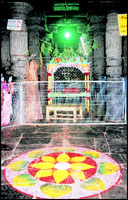 The temple is at a height of 800 feet on the Kailsa Hills in Simhachalam. At the foot of the hill, a tree-sized statue of Hanuman with hands joined in supplication stands impassively, as if welcoming your presence. The Simhachalam Devasthanam runs a Simhadri Bus Service to take pilgrims to the temple from the foothill. The buses leave every 10 minutes and the fares are nominal. A little ahead of the statue of Hanuman, is an Andhra Pradesh Tourism board that describes the legend of Simhachalam. I quote:
The temple is at a height of 800 feet on the Kailsa Hills in Simhachalam. At the foot of the hill, a tree-sized statue of Hanuman with hands joined in supplication stands impassively, as if welcoming your presence. The Simhachalam Devasthanam runs a Simhadri Bus Service to take pilgrims to the temple from the foothill. The buses leave every 10 minutes and the fares are nominal. A little ahead of the statue of Hanuman, is an Andhra Pradesh Tourism board that describes the legend of Simhachalam. I quote: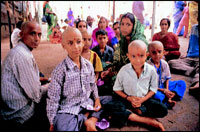 �The temple contains the inscriptions on its pillars narrating the Vijayanagara emperor Sri Krishna Devaraya's success. The architecture and sculpture of the temple is a real feast to the eyes. The temple exhibits a mixture of Dravidian Nagara School of architecture as well as the Deccan style. It is a treasure house of inscriptions. They offer a valuable guide to the chronology of the political and social life of the medieval times beginning from the 11th century and ending in the first quarter of the 17th century.�
�The temple contains the inscriptions on its pillars narrating the Vijayanagara emperor Sri Krishna Devaraya's success. The architecture and sculpture of the temple is a real feast to the eyes. The temple exhibits a mixture of Dravidian Nagara School of architecture as well as the Deccan style. It is a treasure house of inscriptions. They offer a valuable guide to the chronology of the political and social life of the medieval times beginning from the 11th century and ending in the first quarter of the 17th century.�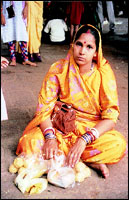 From the car park and bus-stand to the steps of the temple, is an interesting walk. It is an incline, actually, and alongside the steps leading to the temple are lined shops selling all kinds of religious paraphernalia including colourful ribbons, gaudy plastic flowers, photo-frames of various gods, idols in plaster, clay, bronze, wood and even marble, and food items meant to be offered as prasad to Lord Narasimha.
From the car park and bus-stand to the steps of the temple, is an interesting walk. It is an incline, actually, and alongside the steps leading to the temple are lined shops selling all kinds of religious paraphernalia including colourful ribbons, gaudy plastic flowers, photo-frames of various gods, idols in plaster, clay, bronze, wood and even marble, and food items meant to be offered as prasad to Lord Narasimha.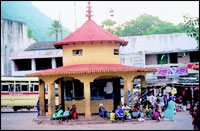 The queues to enter the temple are long, but it is possible, by paying a handsome fee, to skip the queue altogether and go in. I did that, only to discover that photography within the temple is sacreligious. If Lord Narasimha will not be seen but for 12 hours in a year, it is natural that he would not like photographs of himself taken. However, a priest of the temple, who stepped out himself to be photographed, allowed me to shoot one quick frame inside.
The queues to enter the temple are long, but it is possible, by paying a handsome fee, to skip the queue altogether and go in. I did that, only to discover that photography within the temple is sacreligious. If Lord Narasimha will not be seen but for 12 hours in a year, it is natural that he would not like photographs of himself taken. However, a priest of the temple, who stepped out himself to be photographed, allowed me to shoot one quick frame inside.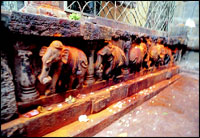 The origins of the temple are shrouded in mystery. An inscription dated as far back as 1087 A.D. of the Chola King Kulothunga is testimony of its existence. For the last two centuries, the family of the Raja of Vizianagaram is the temple's trustees. They have maintained it well, especially the 96 richly carved pillars in black stone, and the fabulous sculptures on the walls.
The origins of the temple are shrouded in mystery. An inscription dated as far back as 1087 A.D. of the Chola King Kulothunga is testimony of its existence. For the last two centuries, the family of the Raja of Vizianagaram is the temple's trustees. They have maintained it well, especially the 96 richly carved pillars in black stone, and the fabulous sculptures on the walls.